5.3: Prokaryotes - Bacteria and Archaea
- Page ID
- 82988
Kingdoms Bacteria and Archaea
- Please read and watch the following Learning Resources
- Reading the material for understanding, and taking notes during videos, will take approximately 1.5 hours.
- Optional Activities are embedded.
- To navigate to the next section, use the Contents menu at the top of the page OR the right arrow on the side of the page.
- If on a mobile device, use the Contents menu at the top of the page OR the links at the bottom of the page.
Learning Objectives
- Describe the basic structure of a typical prokaryote
- Describe important differences in structure between Archaea and Bacteria
- Identify the macronutrients needed by prokaryotes, and explain their importance
- Describe the ways in which prokaryotes get energy and carbon for life processes
- Describe the roles of prokaryotes in the carbon and nitrogen cycles
Introduction
The domain Bacteria comprises all organisms in the kingdom Bacteria, the domain Archaea comprises the rest of the prokaryotes, and the domain Eukarya comprises all eukaryotes—including organisms in the kingdoms Animalia, Plantae, Fungi, and Protista (Figure \(\PageIndex{1}\)).
Unit 5.1 explored the diversity of prokaryotes, their formation, and the role they played in the early Earth. Two of the three domains—Bacteria and Archaea—are prokaryotic. Prokaryotes were the first inhabitants on Earth, appearing 3.5 to 3.8 billion years ago. These organisms are abundant and ubiquitous; that is, they are found everywhere on the planet. In addition to inhabiting moderate environments, they are found in extreme conditions: from boiling springs to permanently frozen environments in Antarctica; from salty environments like the Dead Sea to environments under tremendous pressure, such as the depths of the ocean; and from areas without oxygen, such as a waste management plant, to radioactively contaminated regions (Figure \(\PageIndex{2}\)). In addition, the evolution from prokaryotic to eukaryotic life was explored.
In this section, the focus will be on prokaryotes beginning with the definition of what they are. There are many differences between prokaryotic and eukaryotic cells. However, all cells have four common structures: the plasma membrane, which functions as a barrier for the cell and separates the cell from its environment; the cytoplasm, a jelly-like substance inside the cell; nucleic acids, the genetic material of the cell; and ribosomes, where protein synthesis takes place. Prokaryotes come in many shapes, but most fall into three categories: cocci (spherical), bacilli (rod-shaped), and spirilli (spiral-shaped) (Figure \(\PageIndex{3}\)).
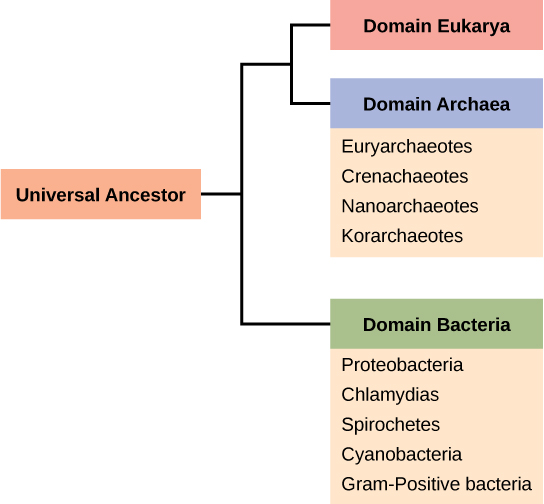
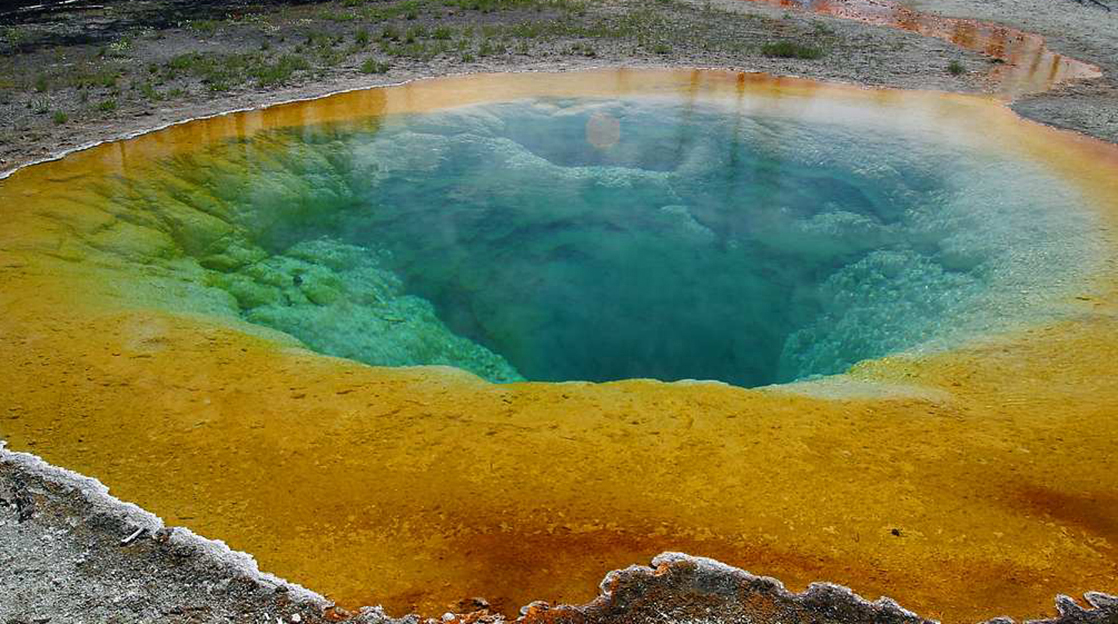
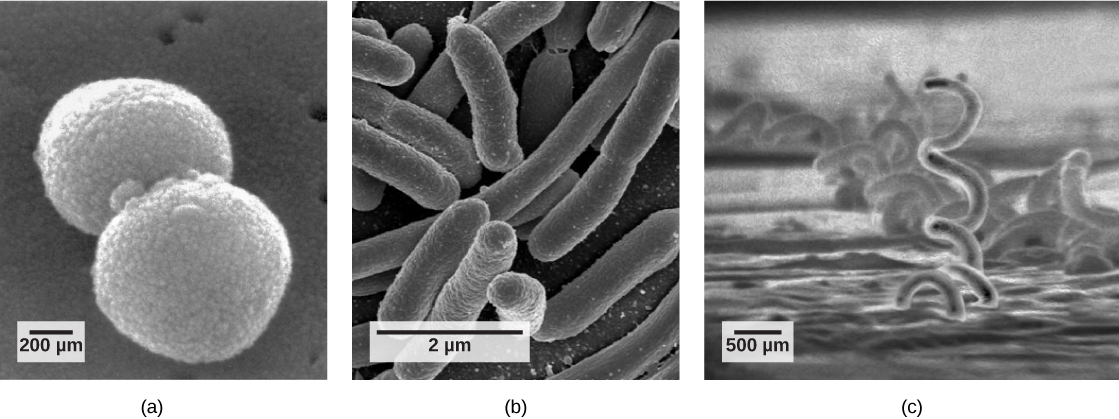
This 7-minute video describes the prokaryotic cells that play an important role in human disease and health. They can cause disease but are also part of the human microbiota and live on our skin, body and on everyday objects in our environment.
Question after watching: In Section 3.3.3, you were asked, in the section called "Current Model", to draw a Venn Diagram showing the similarities and differences between prokaryotes and eukaryotes. While watching this video, add to this Venn Diagram with new information.
Evolution Connection: The Evolution of Prokaryotes
How do scientists answer questions about the evolution of prokaryotes? Unlike animals, prokaryotes have few fossils to offer clues. Fossils of ancient prokaryotes look like tiny bubbles in rock. Scientists turn to genetics and to the principle of the molecular clock to piece together the evolution of prokaryotes. The principle of the molecular clock holds that the more recently two species have diverged, the more similar their genes (and thus proteins) will be. Conversely, species that diverged long ago will have independently accumulated more mutations and will have more dissimilar genes.
Scientists at the NASA Astrobiology Institute and at the European Molecular Biology Laboratory collaborated to analyze the molecular evolution of 32 specific proteins common to 72 species of prokaryotes.1 The model they derived from their data indicates that three important groups of bacteria—Actinobacteria, Deinococcus, and Cyanobacteria (which the authors call Terrabacteria)—were the first to colonize land. (Deinococcus is a genus of prokaryote that is highly resistant to ionizing radiation.) Cyanobacteria are photosynthesizers, while Actinobacteria are a group of common bacteria that include species important in the decomposition of organic wastes.
The timelines of divergence suggest that Bacteria diverged from common ancestral species between 2.5 and 3.2 billion years ago, whereas Archaea diverged earlier: between 3.1 and 4.1 billion years ago. Eukarya later diverged off the Archaean line. The work further suggests that stromatolites that formed prior to the advent of cyanobacteria (about 2.6 billion years ago) photosynthesized in an anoxic environment and that because of the modifications of the Terrabacteria for land (which includes resistance to drying and the possession of compounds that protect the organism from excess light), photosynthesis producing oxygen may be closely linked to adaptations to survive on land.
Which of the following consist of prokaryotic cells?
- Bacteria and Fungi
- Archaea and Fungi
- Protista and Animalia
- Bacteria and Archaea
- Answer
- D. Bacteria and Archaea.
The Prokaryotic Cell
Recall that prokaryotes (Figure \(\PageIndex{4}\)) are unicellular organisms that lack organelles or internal membrane-bound structures. Therefore, they do not have a nucleus. They generally have a single chromosome—a piece of circular, double-stranded DNA located in an area of the cell called the nucleoid. Most prokaryotes have a cell wall outside the plasma membrane.
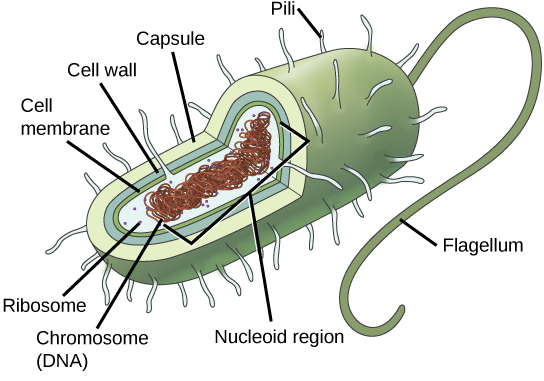
This quick 2-minute video describes the similarities and differences between the two types of prokaryotes: Bacteria and Archaea.
Question after watching: What are three similarities and three differences between Bacteria and Archaea?
The Cell Wall
The cytoplasm of prokaryotic cells has a high concentration of dissolved solutes that the cell needs to function. Therefore, the osmotic pressure within the cell is relatively high. The prokaryotic cell wall is a protective layer that surrounds some cells and gives them shape and rigidity. It is located outside the cell membrane and prevents osmotic lysis (bursting due to increasing volume). The chemical composition of the cell walls varies between Archaea and Bacteria and between bacterial species. The composition of their cell walls is also different from the eukaryotic cell walls found in plants (cellulose) or fungi and insects (chitin).
Bacterial cell walls contain peptidoglycan, composed of polysaccharide chains that are cross-linked by unusual peptides. Many of our antibiotics work by mimicking portions of these chains and therefore have specific effects on bacterial cell wall synthesis. There are more than 100 different forms of peptidoglycan. Surface layer proteins are also present on the outside of cell walls of both Archaea and Bacteria.
Some bacteria have a capsule outside the cell wall. Other structures are present in some prokaryotic species, but not in others (Table \(\PageIndex{1}\)). Up to 90 percent of the cell wall in bacteria without a capsule is composed of peptidoglycan. Most of the rest is composed of acidic substances called teichoic acids. Teichoic acids may be covalently linked to lipids in the plasma membrane to form lipoteichoic acids. Lipoteichoic acids anchor the cell wall to the cell membrane.
Bacterial cells with a capsule have a relatively thin cell wall composed of a few layers of peptidoglycan (only 10 percent of the total cell wall), surrounded by an outer envelope containing lipopolysaccharides (LPS) and lipoproteins. This outer envelope is sometimes referred to as a second lipid bilayer. The chemistry of this outer envelope is very different, however, from that of the typical lipid bilayer that forms plasma membranes.
Researchers and clinicians like to categorize bacteria as belonging to either Gram-positive or Gram-negative. This grouping is based on the result of a quick and easy-to-administer laboratory test that can help researchers and clinicians identify a bacterial species known as Gram staining. Under the Domain Bacteria and the Kingdom Eubacteria, Gram-positive bacteria belong to one phylum; bacteria that are Gram-negative are spread over several phyla.
The different bacterial responses to the staining procedure are ultimately due to cell wall structure. The different bacterial responses to the staining procedure are ultimately due to cell wall structure. Gram-positive organisms typically lack a capsule. Gram-negative organisms have a capsule outside of their cell wall (Figure \(\PageIndex{8}\)).
The Plasma Membrane
As with all living organisms, Bacteria and Archaea have a thin lipid bilayer, the plasma membrane, that surrounds the cell and separates the inside from the outside. Its selectively permeable nature keeps ions, proteins, and other molecules within the cell and prevents them from diffusing into the extracellular environment, while other molecules (usually small, non-polar ones) may move through the membrane. Recall that the general structure of a cell membrane is a phospholipid bilayer composed of two layers of lipid molecules. In archaeal cell membranes, glycerol is linked to isoprene (phytanyl) chains instead of fatty acids chains as in cell membranes of Bacteria and Eukarya. Some archaeal membranes are lipid monolayers instead of bilayers (Figure \(\PageIndex{5}\) and Table \(\PageIndex{1}\)).
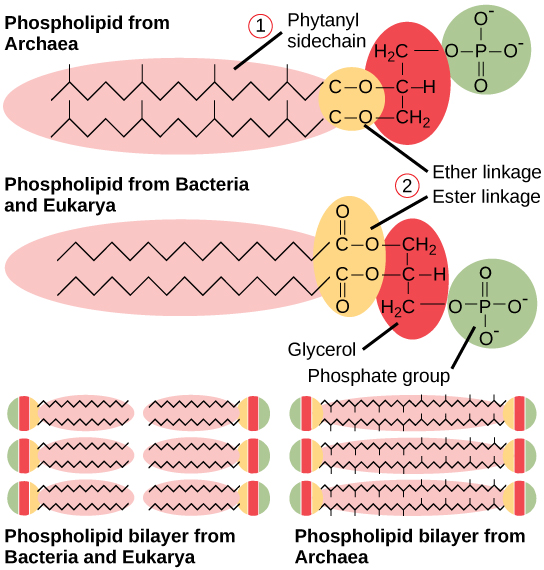
This 9-minute video highlights the similarities and differences between Gram-positive and Gram-negative bacteria.
Question after watching: How does the process of Gram staining differentiate between the two types of bacteria?
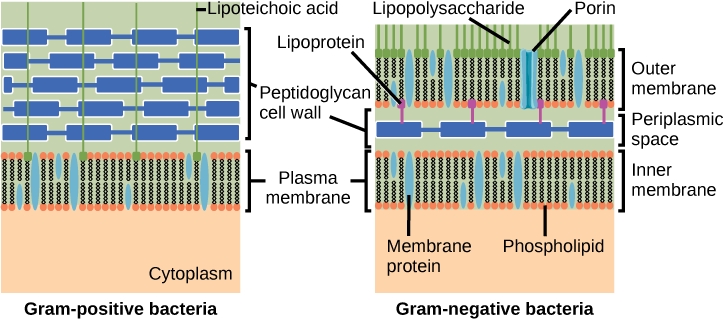
Archaean cell walls do not have peptidoglycan (Table \(\PageIndex{1}\)). There are four different types of Archaean cell walls. One type is composed of pseudopeptidoglycan, which is similar to peptidoglycan in morphology but contains different sugars in the polysaccharide chain. The other three types of cell walls are composed of polysaccharides, glycoproteins, or pure protein.
| Structural Characteristic | Bacteria | Archaea |
|---|---|---|
| Cell type | Prokaryotic | Prokaryotic |
| Cell morphology | Variable | Variable |
| Cell wall | Contains peptidoglycan | Does not contain peptidoglycan |
| Cell membrane type | Lipid bilayer | Lipid bilayer or lipid monolayer |
| Plasma membrane lipids | Fatty acids | Phytanyl groups (contains the lipid isoprene) |
Prokaryotes stain as Gram-positive or Gram-negative because of differences in the cell _______.
- wall
- cytoplasm
- nucleus
- chromosome
- Answer
-
A. wall
Identify three differences between Bacteria and Archaea.
- Answer
-
Responses will vary. A possible answer is: Bacteria contain peptidoglycans in the cell wall; Archaea do not. The cell membrane in Bacteria is a lipid bilayer; in Archaea, it can be a lipid bilayer or a monolayer. Bacteria contain fatty acids on the cell membrane, whereas Archaea contain phytanyl (the lipid isoprene).
Prokaryotic Reproduction
Reproduction in prokaryotes is asexual and usually takes place by binary fission. Recall that the DNA of a prokaryote exists as a single, circular chromosome. Prokaryotes do not undergo mitosis. Rather the chromosome is replicated and the two resulting copies separate from one another, due to the growth of the cell. The prokaryote, now enlarged, is pinched inward at its equator, and the two resulting cells, which are clones, separate. Binary fission does not provide an opportunity for genetic recombination or the generation of genetic diversity, but prokaryotes can share genes by three other mechanisms: transformation, transduction, and conjugation. All three depend on the presence of plasmids. Plasmids, which are extra-chromosomal DNA, are also present in many species of Bacteria and Archaea.
In transformation, the prokaryote takes in DNA found in its environment that is shed by other prokaryotes. If a nonpathogenic bacterium takes up DNA for a toxin gene from a pathogen and incorporates the new DNA into its own chromosome, it also may become pathogenic.
In transduction, bacteriophages, the viruses that infect bacteria, move short pieces of chromosomal DNA from one bacterium to another. Transduction results in a recombinant organism. Archaea are not affected by bacteriophages but instead have their own viruses that translocate genetic material from one individual to another.
In conjugation, DNA is transferred from one prokaryote to another by means of a pilus, which brings the organisms into contact with one another. The DNA transferred can be in the form of a plasmid or as a hybrid, containing both plasmid and chromosomal DNA. These three processes of DNA exchange are shown in Figure \(\PageIndex{7}\).
Reproduction can be very rapid: a few minutes for some species. This short generation time coupled with mechanisms of genetic recombination and high rates of mutation results in the rapid evolution of prokaryotes, allowing them to respond to environmental changes (such as the introduction of an antibiotic) very quickly.
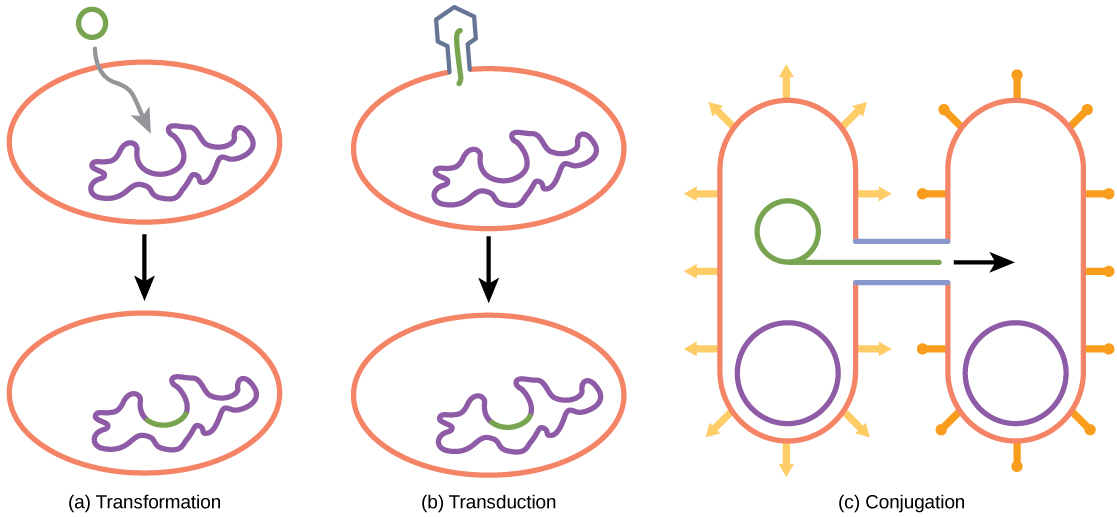
These two videos (7.5-minutes and 6-minutes, respectively) summarize the two Domains and Kingdoms of prokaryotes: Bacteria and Archaea
Question after watching: In what ways are prokaryotes problematic and helpful for humans?
Prokaryotic Metabolism
The diverse environments and ecosystems on Earth have a wide range of conditions in terms of temperature, available nutrients, acidity, salinity, and energy sources. Prokaryotes are very well equipped to make their living out of a vast array of nutrients and conditions. To live, prokaryotes need a source of energy, a source of carbon, and some additional nutrients.
Energy and Carbon Sources
Prokaryotes can use different sources of energy to assemble macromolecules from smaller molecules. Photoautotrophs (or phototrophic organisms) obtain their energy from sunlight. Chemoautotrophs (or chemosynthetic organisms) obtain their energy from chemical compounds. Chemoautotrophs that can use organic compounds as energy sources are called chemoorganotrophs. Those that can also use inorganic compounds as energy sources are called chemolitotrophs.
Prokaryotes not only can use different sources of energy but also different sources of carbon compounds. Organisms that can fix inorganic carbon into organic molecules are called autotrophs. Autotrophic prokaryotes synthesize organic molecules from carbon dioxide. In contrast, heterotrophic prokaryotes obtain carbon from organic compounds.
To make the picture more complex, the terms that describe how prokaryotes obtain energy and carbon can be combined. Thus, photoautotrophs use energy from sunlight, and carbon from carbon dioxide and water, whereas chemoheterotrophs obtain energy and carbon from an organic chemical source. Chemolitoautotrophs obtain their energy from inorganic compounds, and they build their complex molecules from carbon dioxide. Table \(\PageIndex{2}\) summarizes carbon and energy sources in prokaryotes.
| Energy Source | ||
| Carbon Source | Sunlight | Chemicals (such as sulfur dioxide, iron, etc.) |
| Carbon Dioxide (from the atmosphere or water) | Photoautotrophs | Chemoautotrophs |
| Organic Compounds (from other organic matter) | Photoheterotrophs | Chemoheterotrophs |
Prokaryotes that obtain their energy from chemical compounds are called _____.
- phototrophs
- auxotrophs
- chemotrophs
- lithotrophs
- Answer
-
C. chemotrophs
Prokaryote Niches and Habitats
Prokaryotes are ubiquitous: There is no niche or ecosystem in which they are not present. Prokaryotes play many roles in the environments they occupy. The roles they play in the carbon and nitrogen cycles are vital to life on Earth.
Beneficial Prokaryotes
Not all prokaryotes are pathogenic. On the contrary, pathogens represent only a very small percentage of the diversity of the microbial world. In fact, our life would not be possible without prokaryotes. Just think about the role of prokaryotes in biogeochemical cycles.
Prokaryotes and the Carbon Cycle
Carbon is one of the most important macronutrients, and prokaryotes play an important role in the carbon cycle (Figure \(\PageIndex{8}\)). Carbon is cycled through Earth’s major reservoirs: land, the atmosphere, aquatic environments, sediments and rocks, and biomass. The movement of carbon is via carbon dioxide, which is removed from the atmosphere by land plants and marine prokaryotes in photosynthesis and is returned to the atmosphere via the respiration of chemoorganotrophic organisms, including prokaryotes, fungi, and animals. Although the largest carbon reservoir in terrestrial ecosystems is in rocks and sediments, that carbon is not readily available.
A large amount of available carbon is found in land plants. Plants, which are producers, use carbon dioxide from the air to synthesize carbon compounds (i.e. organic molecules). Related to this, one very significant source of carbon compounds is humus, which is a mixture of prokaryotes and organic materials from dead plants that have resisted decomposition. Consumers such as animals use organic compounds generated by producers and release carbon dioxide into the atmosphere when they respire. Then, bacteria and fungi, collectively called decomposers, carry out the breakdown (decomposition) of plants and animals and their organic compounds. The most important contributor of carbon dioxide to the atmosphere is microbial decomposition of dead material (dead animals, plants, and humus) through respiration.
In aqueous environments and their anoxic sediments, there is another carbon cycle taking place. In this case, the cycle is based on one-carbon compounds. In anoxic sediments, prokaryotes, mostly archaea, produce methane (CH4). This methane moves into the zone above the sediment, which is richer in oxygen and supports bacteria called methane oxidizers that oxidize methane to carbon dioxide as a way to fuel their energy needs. The carbon dioxide produced then returns to the atmosphere.
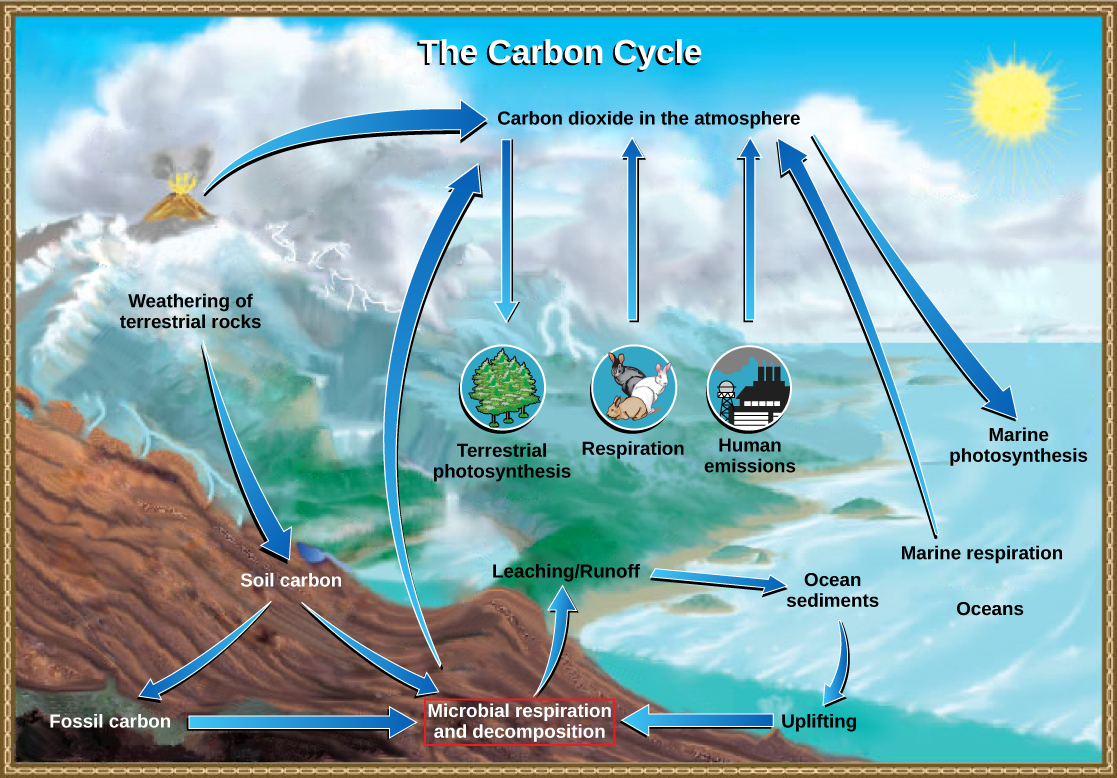
Prokaryotes and the Nitrogen Cycle
Nitrogen is a very important element for life because it is part of proteins and nucleic acids. It is a macronutrient, and in nature, it is recycled from organic compounds to ammonia (NH3), ammonium ions (NH4+), nitrate (NO-3), nitrite (NO-2), and nitrogen gas (N2) by myriad processes, many of which are carried out only by prokaryotes. As illustrated in Figure \(\PageIndex{9}\), prokaryotes are key to the nitrogen cycle. The largest pool of nitrogen available in the terrestrial ecosystem is gaseous nitrogen from the air, but this nitrogen is not usable by plants, which are primary producers.
Gaseous nitrogen is transformed, or “fixed” into more readily available forms such as ammonia through the process of nitrogen fixation. Bacteria in the soil or living on or in plant roots perform this function, making nitrogen available to plants. Ammonia can be used by plants or converted to other forms.
Another source of ammonia is ammonification, the process by which ammonia is released during the decomposition of nitrogen-containing organic compounds. The majority of the nitrogen produced during ammonification is N2. The rest is as NH4+ and nitrous oxides (NxO). Ammonia is catabolized anaerobically, meaning no oxygen needs to be present. This process can therefore take place deep in the soil by some prokaryotes.
Nitrification is the conversion of ammonium to nitrite and nitrate. Nitrification in soils is carried out by bacteria belonging to the genera Nitrosomas, Nitrobacter, and Nitrospira. The bacteria performs the reverse process, the reduction of nitrate from the soils to gaseous compounds such as N2O, NO, and N2, a process called denitrification. In this way, nitrogen is returned from the soil to the atmosphere.
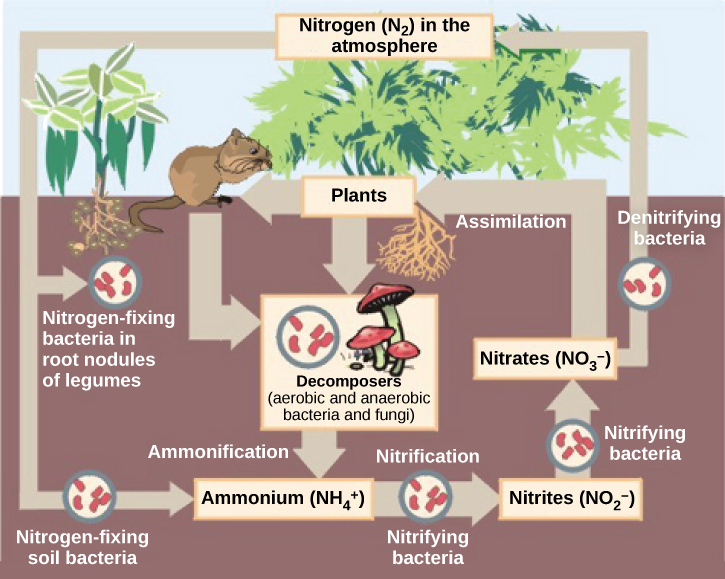
Ammonification is the process by which _____.
- ammonia is released during the decomposition of nitrogen-containing organic compounds
- ammonium is converted to nitrite and nitrate in soils
- nitrate from soil is transformed to gaseous nitrogen compounds such as NO, N2O, and N2
- gaseous nitrogen is fixed to yield ammonia
- Answer
-
A. ammonia is released during the decomposition of nitrogen-containing organic compounds
Early Biotechnology: Cheese, Bread, Wine, Beer, and Yogurt
According to the United Nations Convention on Biological Diversity, biotechnology is “any technological application that uses biological systems, living organisms, or derivatives thereof, to make or modify products or processes for specific use."1 The concept of “specific use” involves some sort of commercial application. Genetic engineering, artificial selection, antibiotic production, and cell culture are current topics of study in biotechnology. However, humans have used prokaryotes before the term biotechnology was even coined. In addition, some of the goods and services are as simple as cheese, bread, wine, beer, and yogurt, which employ both bacteria and other microbes, such as yeast, a fungus (Figure \(\PageIndex{2}\)).
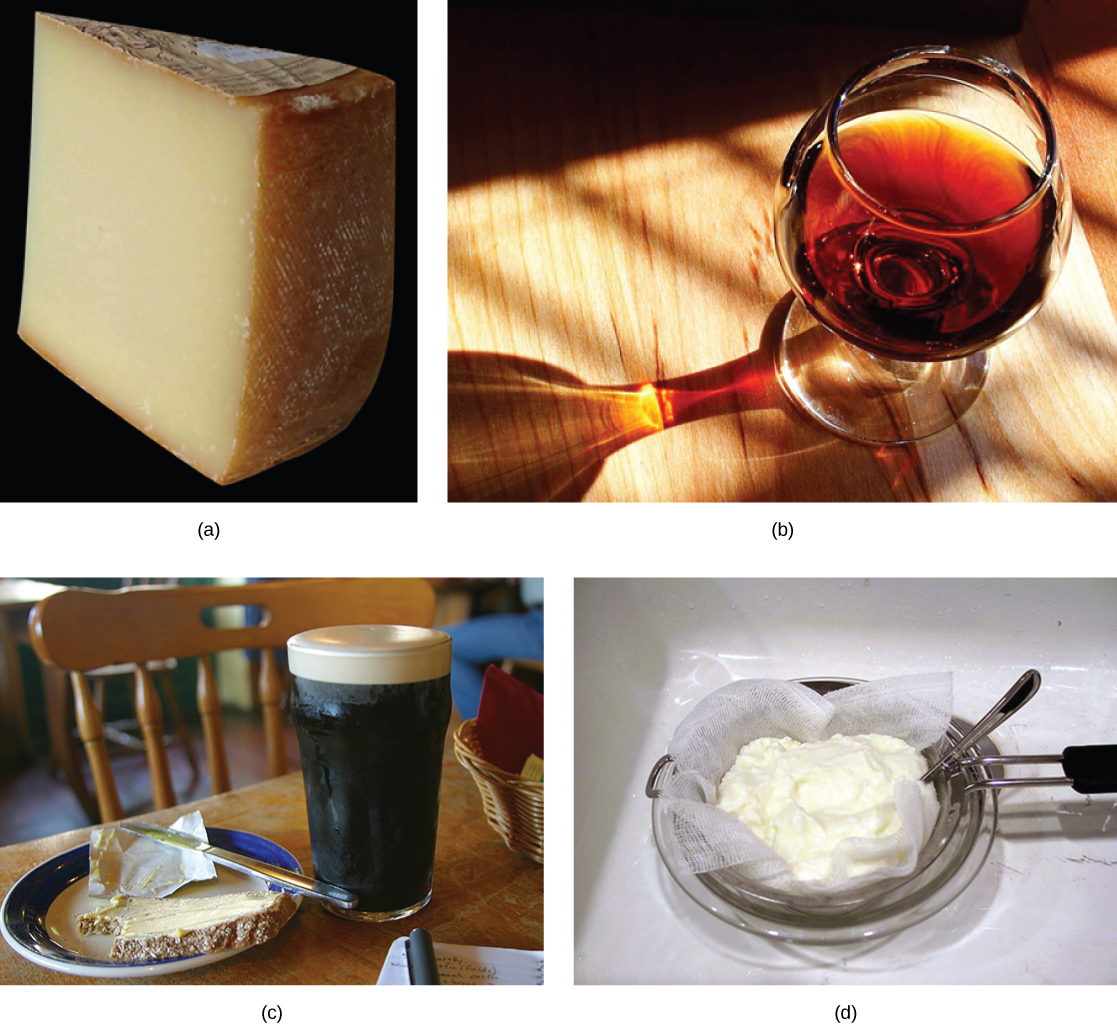
Figure \(\PageIndex{10}\): Some of the products derived from the use of prokaryotes in early biotechnology include (a) cheese, (b) wine, (c) beer and bread, and (d) yogurt. (credit bread: modification of work by F. Rodrigo/Wikimedia Commons; credit wine: modification of work by Jon Sullivan; credit beer and bread: modification of work by Kris Miller; credit yogurt: modification of work by Jon Sullivan)
Cheese production began around 4,000–7,000 years ago when humans began to breed animals and process their milk. Fermentation in this case preserves nutrients: Milk will spoil relatively quickly, but when processed as cheese, it is more stable. As for beer, the oldest records of brewing are about 6,000 years old and refer to the Sumerians. Evidence indicates that the Sumerians discovered fermentation by chance. Wine has been produced for about 4,500 years, and evidence suggests that cultured milk products, like yogurt, have existed for at least 4,000 years.
Where does bread get its fluffiness? Swiss cheese its holes? And what makes vinegar so sour?
Question after watching: Can you think of everyday products outside the kitchen being made using biological processes?
Microbes on the Human Body
The commensal bacteria that inhabit our skin and gastrointestinal tract do a host of good things for us. They protect us from pathogens, help us digest our food, and produce some of our vitamins and other nutrients. These activities have been known for a long time. More recently, scientists have gathered evidence that these bacteria may also help regulate our moods, influence our activity levels, and even help control weight by affecting our food choices and absorption patterns. The Human Microbiome Project has begun the process of cataloging our normal bacteria (and archaea) so we can better understand these functions.
A particularly fascinating example of our normal flora relates to our digestive systems. People who take high doses of antibiotics tend to lose many of their normal gut bacteria, allowing a naturally antibiotic-resistant species called Clostridium difficile to overgrow and cause severe gastric problems, especially chronic diarrhea (Figure \(\PageIndex{11}\)). Obviously, trying to treat this problem with antibiotics only makes it worse. However, it has been successfully treated by giving the patients fecal transplants from healthy donors to reestablish the normal intestinal microbial community. Clinical trials are underway to ensure the safety and effectiveness of this technique.
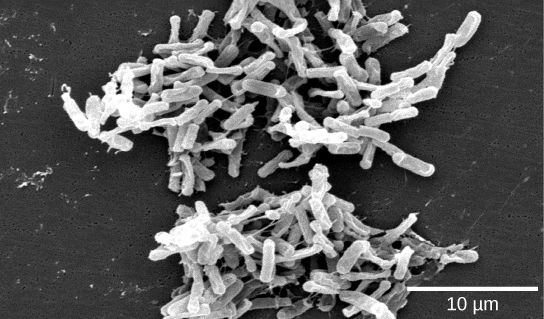
Scientists are also discovering that the absence of certain key microbes from our intestinal tract may set us up for a variety of problems. This seems to be particularly true regarding the appropriate functioning of the immune system. There are intriguing findings that suggest that the absence of these microbes is an important contributor to the development of allergies and some autoimmune disorders. Research is currently underway to test whether adding certain microbes to our internal ecosystem may help in the treatment of these problems as well as in treating some forms of autism.
Using Prokaryotes to Clean up Our Planet: Bioremediation
Microbial bioremediation is the use of prokaryotes (or microbial metabolism) to remove pollutants. Bioremediation has been used to remove agricultural chemicals (pesticides, fertilizers) that leach from soil into groundwater and the subsurface. Certain toxic metals and oxides, such as selenium and arsenic compounds, can also be removed from water by bioremediation. The reduction of SeO4-2 to SeO3-2 and to Se0 (metallic selenium) is a method used to remove selenium ions from water. Mercury is an example of a toxic metal that can be removed from an environment by bioremediation. As an active ingredient of some pesticides, mercury is used in industry and is also a by-product of certain processes, such as battery production. Methyl mercury (Hg+2) is usually present in very low concentrations in natural environments, but it is highly toxic because it accumulates in living tissues. Several species of bacteria can carry out the biotransformation of toxic mercury into nontoxic forms. These bacteria, such as Pseudomonas aeruginosa, can convert Hg+2 into Hg0, which is nontoxic to humans.
One of the most useful and interesting examples of the use of prokaryotes for bioremediation purposes is the cleanup of oil spills. The importance of prokaryotes to petroleum bioremediation has been demonstrated in several oil spills in recent years, such as the Exxon Valdez spill in Alaska (1989) (Figure \(\PageIndex{12}\)), the Prestige oil spill in Spain (2002), the spill into the Mediterranean from a Lebanon power plant (2006), and more recently, the BP oil spill in the Gulf of Mexico (2010). To clean up these spills, bioremediation is promoted by the addition of inorganic nutrients that help bacteria to grow. Hydrocarbon-degrading bacteria feed on hydrocarbons in the oil droplet, breaking down the hydrocarbons. Some species, such as Alcanivorax borkumensis, produce surfactants that solubilize the oil, whereas other bacteria degrade the oil into carbon dioxide. In the case of oil spills in the ocean, ongoing, natural bioremediation tends to occur, inasmuch as there are oil-consuming bacteria in the ocean prior to the spill. In addition to naturally occurring oil-degrading bacteria, humans select and engineer bacteria that possess the same capability with increased efficacy and spectrum of hydrocarbon compounds that can be processed. Under ideal conditions, it has been reported that up to 80 percent of the nonvolatile components in oil can be degraded within one year of the spill. Other oil fractions containing aromatic and highly branched hydrocarbon chains are more difficult to remove and remain in the environment for longer periods of time.
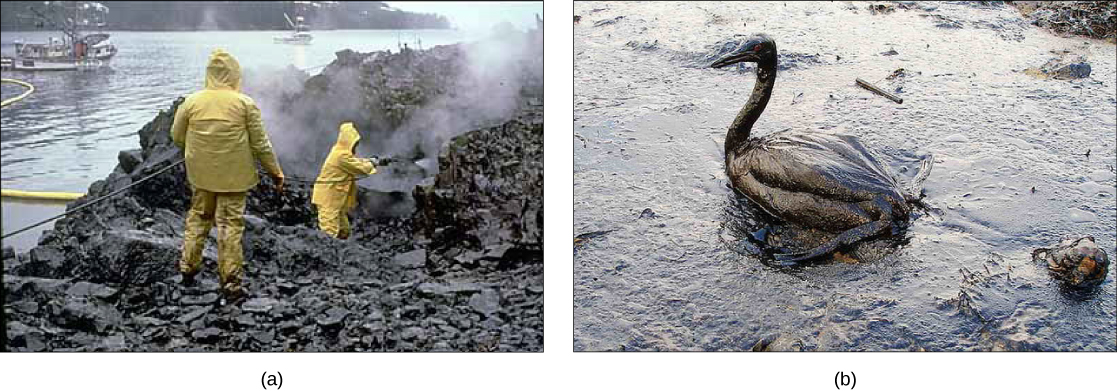
Bacteria as Pathogens
Devastating pathogen-borne diseases and plagues, both viral and bacterial in nature, have affected humans since the beginning of human history. The true cause of these diseases was not understood at the time, and some people thought that diseases were a spiritual punishment. Over time, people came to realize that staying apart from afflicted persons, and disposing of the corpses and personal belongings of victims of illness, reduced their own chances of getting sick.
Epidemiologists study how diseases affect a population. An epidemic is a disease that occurs in an unusually high number of individuals in a population at the same time. A pandemic is a widespread, usually worldwide, epidemic. An endemic disease is a disease that is constantly present, usually at low incidence, in a population.
There are records about infectious diseases as far back as 3000 B.C. A number of significant pandemics caused by bacteria have been documented over several hundred years. Some of the most memorable pandemics led to the decline of cities and nations.
In the 21st century, infectious diseases remain among the leading causes of death worldwide, despite advances made in medical research and treatments in recent decades. A disease spreads when the pathogen that causes it is passed from one person to another. For a pathogen to cause disease, it must be able to reproduce in the host’s body and damage the host in some way.
The Plague of Athens
In 430 B.C., the Plague of Athens killed one-quarter of the Athenian troops that were fighting in the great Peloponnesian War and weakened Athens’ dominance and power. The plague impacted people living in overcrowded Athens as well as troops aboard ships that had to return to Athens. The source of the plague may have been identified recently when researchers from the University of Athens were able to use DNA from teeth recovered from a mass grave. The scientists identified nucleotide sequences from a pathogenic bacterium, Salmonella enterica serovar Typhi (Figure \(\PageIndex{13}\)), which causes typhoid fever. This disease is commonly seen in overcrowded areas and has caused epidemics throughout recorded history.
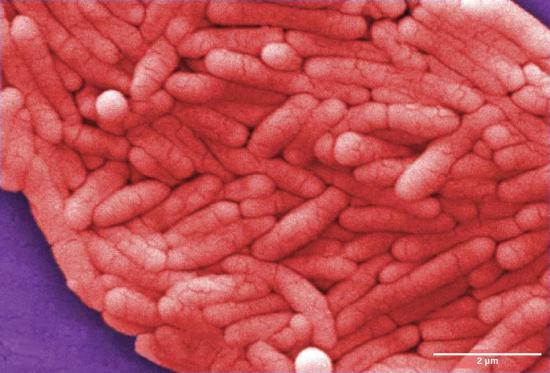
Bubonic Plagues
From 541 to 750, an outbreak of what was likely a bubonic plague (the Plague of Justinian), eliminated one-quarter to one-half of the human population in the eastern Mediterranean region. The population in Europe dropped by 50 percent during this outbreak. Bubonic plague would strike Europe more than once.
One of the most devastating pandemics was the Black Death (1346 to 1361) that is believed to have been another outbreak of bubonic plague caused by the bacterium Yersinia pestis. It is thought to have originated initially in China and spread along the Silk Road, a network of land and sea trade routes, to the Mediterranean region and Europe, carried by rat fleas living on black rats that were always present on ships. The Black Death reduced the world’s population from an estimated 450 million to about 350 to 375 million. Bubonic plague struck London hard again in the mid-1600s (Figure \(\PageIndex{14}\)). In modern times, approximately 1,000 to 3,000 cases of plague arise globally each year. Although contracting bubonic plague before antibiotics meant almost certain death, the bacterium responds to several types of modern antibiotics, and mortality rates from plague are now very low.
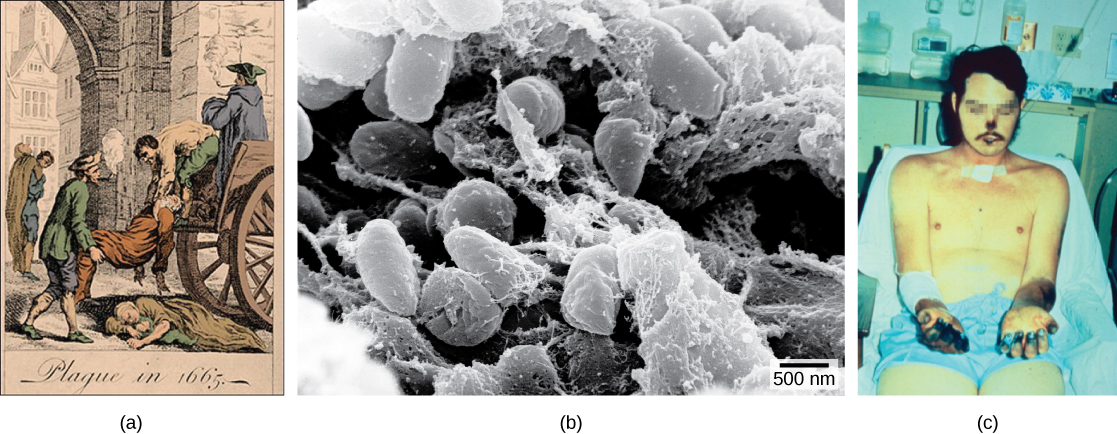
Migration of Diseases to New Populations
Over the centuries, Europeans tended to develop genetic immunity to endemic infectious diseases, but when European conquerors reached the western hemisphere, they brought with them disease-causing bacteria and viruses, which triggered epidemics that completely devastated populations of Native Americans, who had no natural resistance to many European diseases. It has been estimated that up to 90 percent of Native Americans died from infectious diseases after the arrival of Europeans, making conquest of the New World a foregone conclusion.
Emerging and Re-emerging Diseases
The distribution of a particular disease is dynamic. Therefore, changes in the environment, the pathogen, or the host population can dramatically impact the spread of a disease. According to the World Health Organization (WHO) an emerging disease is one that has appeared in a population for the first time, or that may have existed previously but is rapidly increasing in incidence or geographic range. This definition also includes re-emerging diseases that were previously under control. Approximately 75 percent of recently emerging infectious diseases affecting humans are zoonotic diseases, zoonoses, diseases that primarily infect animals and are transmitted to humans; some are of viral origin and some are of bacterial origin. Brucellosis is an example of a prokaryotic zoonosis that is re-emerging in some regions, and necrotizing fasciitis (commonly known as flesh-eating bacteria) has been increasing in virulence for the last 80 years for unknown reasons.
Some of the present emerging diseases are not actually new, but are diseases that were catastrophic in the past (Figure \(\PageIndex{15}\)). They devastated populations and became dormant for a while, just to come back, sometimes more virulent than before, as was the case with bubonic plague. Other diseases, like tuberculosis, were never eradicated but were under control in some regions of the world until coming back, mostly in urban centers with high concentrations of immunocompromised people. The WHO has identified certain diseases whose worldwide re-emergence should be monitored. Among these are two viral diseases (dengue fever and yellow fever), and three bacterial diseases (diphtheria, cholera, and bubonic plague). The war against infectious diseases has no foreseeable end.
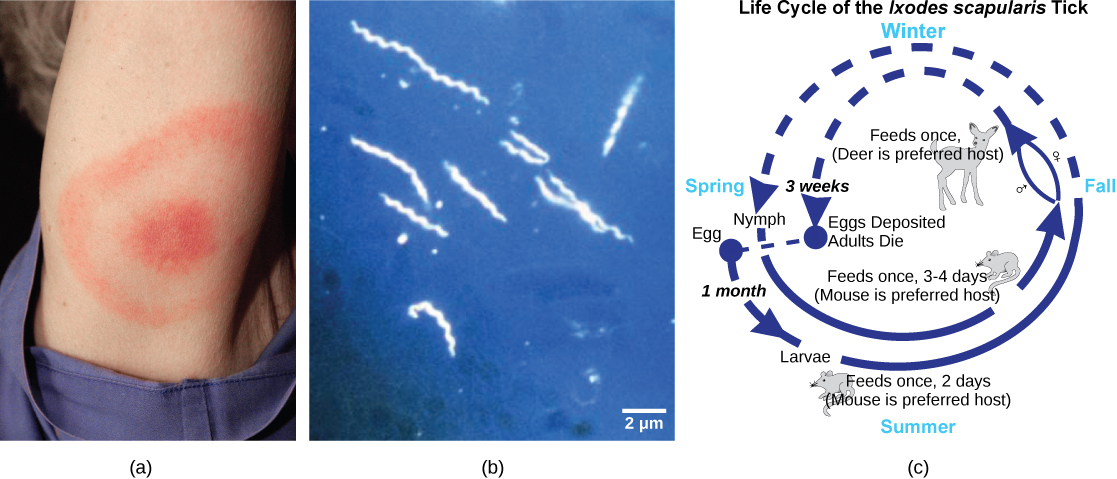
Biofilms and Disease
Recall that biofilms are microbial communities that are very difficult to destroy. They are responsible for diseases such as infections in patients with cystic fibrosis, Legionnaires’ disease, and otitis media. They produce dental plaque and colonize catheters, prostheses, transcutaneous and orthopedic devices, contact lenses, and internal devices such as pacemakers. They also form in open wounds and burned tissue. In healthcare environments, biofilms grow on hemodialysis machines, mechanical ventilators, shunts, and other medical equipment. In fact, 65 percent of all infections acquired in the hospital (nosocomial infections) are attributed to biofilms. Biofilms are also related to diseases contracted from food because they colonize the surfaces of vegetable leaves and meat, as well as food-processing equipment that isn’t adequately cleaned.
Biofilm infections develop gradually; sometimes, they do not cause symptoms immediately. They are rarely resolved by host defense mechanisms. Once an infection by a biofilm is established, it is very difficult to eradicate, because biofilms tend to be resistant to most of the methods used to control microbial growth, including antibiotics. Biofilms respond poorly or only temporarily to antibiotics; it has been said that they can resist up to 1,000 times the antibiotic concentrations used to kill the same bacteria when they are free-living or planktonic. An antibiotic dose that large would harm the patient; therefore, scientists are working on new ways to get rid of biofilms.
Antibiotics: Are We Facing a Crisis?
Explore how bacteria become resistant to antibiotics and turn into superbugs, and what scientists are doing to stop it.
Question after watching: Not all bacteria are antibiotic-resistant. How might some of those non-resistant bacteria become antibiotic-resistant?
The word antibiotic comes from the Greek anti meaning “against” and bios meaning “life.” An antibiotic is a chemical, produced either by microbes or synthetically, that is hostile to the growth of other organisms. Today’s news and media often address concerns about an antibiotic crisis. Are the antibiotics that easily treated bacterial infections in the past becoming obsolete? Are there new “superbugs”—bacteria that have evolved to become more resistant to our arsenal of antibiotics? Is this the beginning of the end of antibiotics? All these questions challenge the healthcare community.
One of the main causes of resistant bacteria is the abuse of antibiotics. The imprudent and excessive use of antibiotics has resulted in the natural selection of resistant forms of bacteria. The antibiotic kills most of the infecting bacteria, and therefore only the resistant forms remain. These resistant forms reproduce, resulting in an increase in the proportion of resistant forms over non-resistant ones. Another major misuse of antibiotics is in patients with colds or the flu, for which antibiotics are useless. Another problem is the excessive use of antibiotics in livestock. The routine use of antibiotics in animal feed promotes bacterial resistance as well. In the United States, 70 percent of the antibiotics produced are fed to animals. These antibiotics are given to livestock in low doses, which maximizes the probability of resistance developing, and these resistant bacteria are readily transferred to humans.
Footnotes
- 1 Battistuzzi, FU, Feijao, A, and Hedges, SB. A genomic timescale of prokaryote evolution: Insights into the origin of methanogenesis, phototrophy, and the colonization of land. BioMed Central: Evolutionary Biology 4 (2004): 44, doi:10.1186/1471-2148-4-44.
Thumbnail: Scanning electron micrograph of neutrophil ingesting methicillin-resistant Staphylococcus aureus bacteria. (Public Domain; NIAID/NIH).


